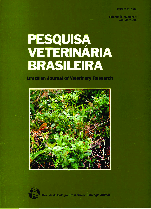 |
|
|
|
Year 1998 - Volume 18, Number 1
|

|
Evaluation of the sensitivity of bulk tank milk cultures for the isolation of contagious bovine mastitis pathogens, 18(1):39-44
|
ABSTRACT.- Brito M.A.V.P., Brito J.R.F., Souza H.M. & Vargas O.L. 1998. [Evaluation of the sensitivity of bulk tank milk cultures for the isolation of contagious bovine mastitis pathogens.] Avaliação da sensibilidade da cultura de leite do tanque para isolamento de agentes contagiosos da mastite bovina. Pesquisa Veterinária Brasileira 18(1):39-44. Embrapa-Centro Nacional de Pesquisa de Gado de Leite, Juiz de Fora, MG 36038-330, Brazil.
Samples of bulk tank milk from 33 herds were collected at the dairy processing plant and cultured, as a means of detecting specific (contagious) bovine mastitis pathogens. Somatic cell counts (SCC) were made on a Fossomatic 90. Two and three weekly consecutive samples were obtained from 13 and 12 herds, respectively. Only one sample was examined from eight herds. Three daily consecutive samples of bulk milk and individual quarter samples from all lactating cows from four herds (A, B, C and D) were also examined. Milk from individual quarters were cultured on blood agar while tank milk samples were cultured on TKT, Mannitol Salt, MacConkey agars and Sabouraud containing chloramphenicol. Staphylococcus aureus was recovered from 26 of the 33 herds sampled in the dairy processing plant. Nine of these samples also contained Streptococcus agalactiae. Nine herds had SCC above 500,000 ml1 The remaining 23 herds had SCC levels below 400,000 ml1 S. aureus and S. agalactiae were isolated from five of the nine herds with high SCC, S. agalactiae from one and S. aureus from three. Six herds had SSC below 200,000 ml1 S. aureus and S. agalactiae were isolated from one, S. aureus from three, while the other two were negative for both pathogens. The results of herds A, B, C and D sampled at the farms showed that S. aureus was isolated from 1.8%, 19.2%, 17.0% and 8.4% of the animals and 0.9%, 5.9%, 5.4% and 2.2% of the mammary quarters, respectively. S. agalactiae was isolated from herds A, C and D. Within these herds the percentages of isolation were, respectively, 1.8%, 10.6% and 8.4% for the cows and 0.46%, 3.8% and 3.7% for the mammary quarters. S. aureus was recovered from all three bulk tank cultures from herds A, B and D. Only the third sample from herd C was positive for S. aureus. S. agalactiae was recovered from all samples collected from herd D, two samples from herd C and one sample from herd A. Coliforms were isolated from all tank samples from herds A, B, C and D and from all but one sample collected in the processing plant. Yeasts were recovered from 16 herds sampled at the processing plant and from all tank samples from herds A, B, C, and D. Neither coliforms or yeasts were isolated from the individual animals of herds A, B, C and D. These findings indicate that the milk was contaminated during or after milking, probably due to deficient hygiene and cleaning procedures. The analysis of the bulk tank milk cultures showed that the test was sensitive enough to detect contagious mastitis pathogens. The sensitivity of the test increased when more than two consecutive samples were examined. |
| |
|
|
| |
|
 |